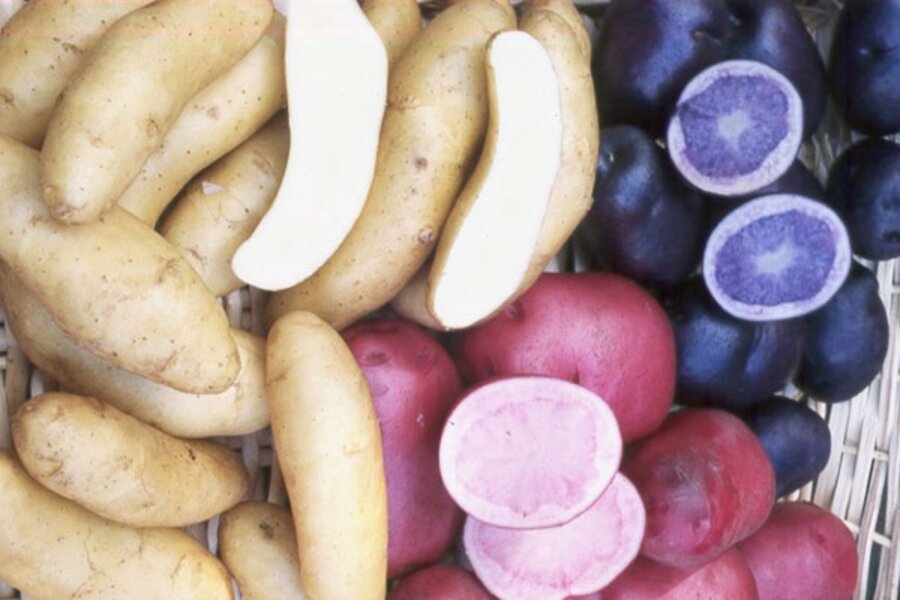The Edible Explorer: ancient All-Blue potatoes
Loading...
As a kid I hated potatoes. It might be because my mom cooked only mashed potatoes, the consistency of wallpaper paste, with no gravy. Adulthood wasn’t much better; I even avoided French fries. Children changed the equation; I needed to set a positive example.
A seed catalog arrived one spring with photos of vivid blue-skinned potatoes. The flesh was blue, too. I thought that my son would eat them out of curiosity. I was really projecting my own potato problems, because he already was a French fry and baked potato fan.
With thoughts of crisp blue potato skins heaped with bacon bits and melted cheese, I planted the first All Blue potato in 1990. I’ve been hooked ever since. I even eat blue mashed potatoes.
All Blue potatoes (see first photo above) are probably the most direct descendant of potatoes found almost 10,000 years ago high in the Peruvian Andes mountains. Blue and purple pigments developed as mechanisms to shield tubers from excessive levels of ultraviolet light found at high altitudes.
Any potato tuber exposed to direct sunlight turns green; the color indicates that large amounts of solanine are present. All potatoes contain tiny amounts of solanine, but portions turned green by the sun contain toxic amounts. The first potatoes grew in crevices and rocky outcroppings where the soil is very shallow. Developing tubers had only a scant layer of dirt to cover them, so purple and blue pigments evolved over time as a natural sunshade.
Any potato is easy to grow, and All Blues are even easier, as they seem to resist fungal diseases that accompany rainy weather. I place tubers on top of a garden bed (see second photo above) that has been enriched with compost and a bit of soil sulfur. Potatoes develop scab in alkaline soils (6.0 to 6.5 pH is ideal), and my ground is 7.2 pH. So I add sulfur to acidify the soil.
I use whole tubers, instead of cutting them into chunks, as many gardeners do. I feel that I’m avoiding a rot problem, as early spring in my area is cold and wet. After spacing the potatoes about 12 inches apart in every direction, I cover the bed with about a foot of straw. That’s all I do.
Another easy technique is to grow potatoes in a wire cage above the ground. Click here for details. You can start harvesting baby or “new” potatoes when plants flower. And, yes, the flowers are blue, too!
All Blue facts
• Plants survive temperatures down to 15 degrees F. (-9 C) with little or no protection. Place a double layer of newspaper over plants when freezes threaten and foliage is still actively growing.
• Tubers have a nutty flavor and are excellent in salads and roasted. They are an all-around-use potato with medium starch content.
• Microwave to retain the blue color, or steam potatoes just to the point of tenderness. Baking, boiling, and stewing will fade colors slightly.
• Blue-fleshed potatoes have more vitamins and antioxidants than white potatoes. In fact, All Blue potatoes have as much antioxidant power as Brussels sprouts, kale, and spinach.
If it’s edible and unusual, Doreen Howard figures out a way to grow it in her USDA Zone 4b garden. She’ll try anything once, even smelly Durian. A former garden editor at Woman’s Day, she writes regularly for The American Gardener and The Old Farmer’s Almanac’s Garden Guide.
Editor’s note: To read more gardening posts by Doreen, check our blog archive. Click on our main gardening page for more articles on many garden topics. Here's our RSS feed.
You may also want to visit Gardening With the Monitor on Flickr. Join the group (it’s free) and upload your garden photos — and possibly win a prize. (The next contest begins net week.) Join the discussions and get answers to your gardening questions.





